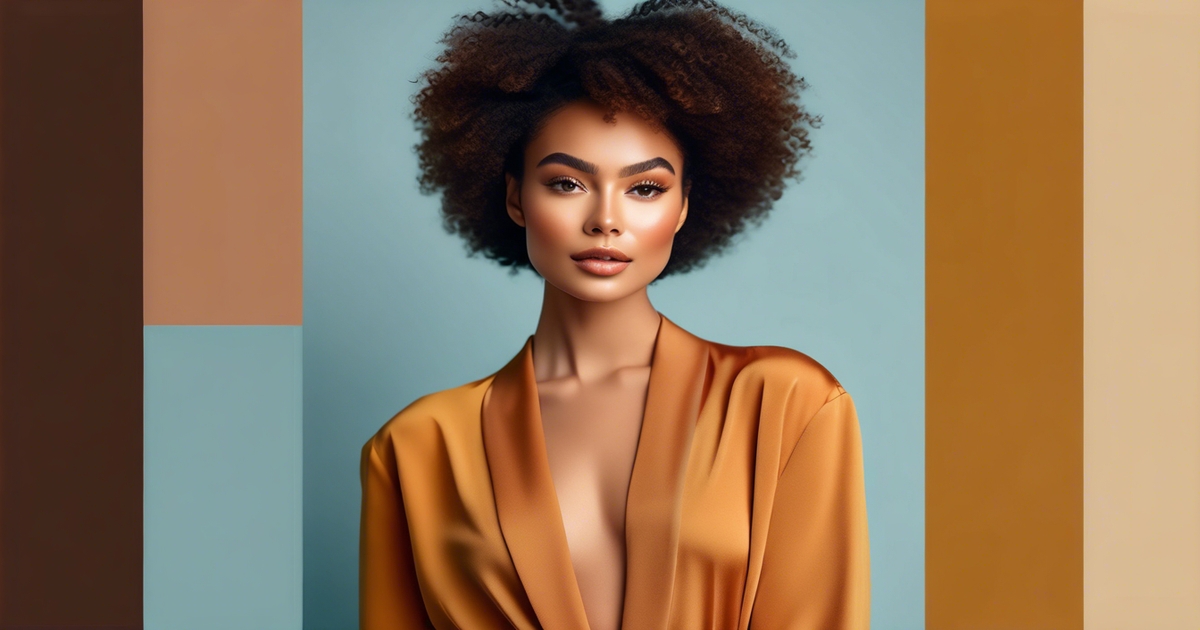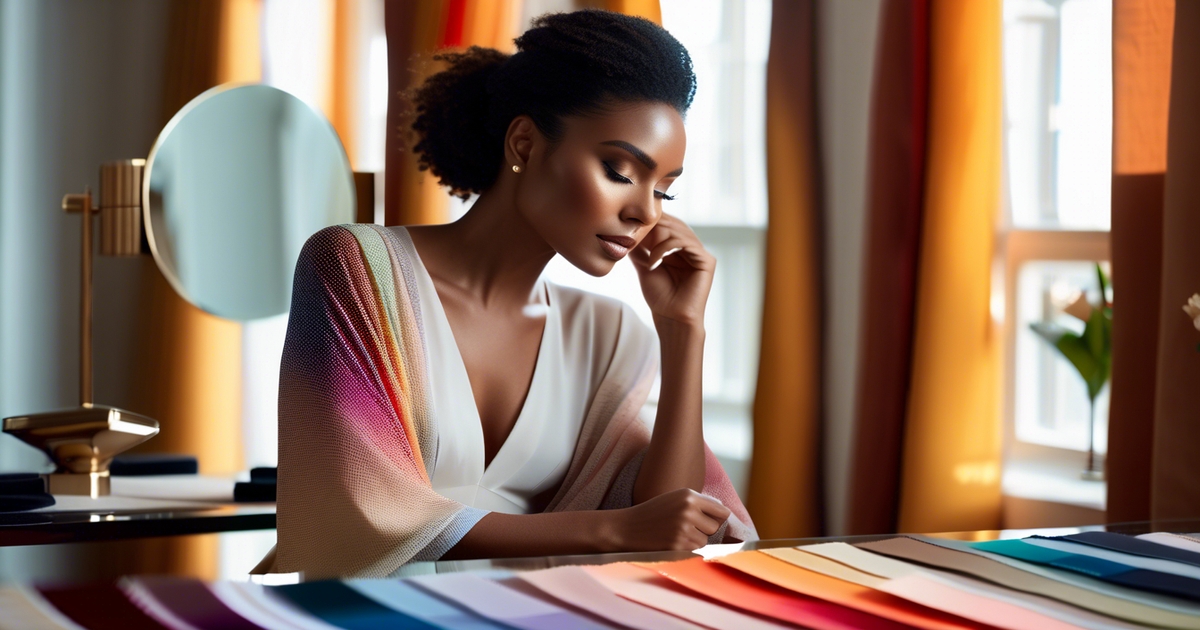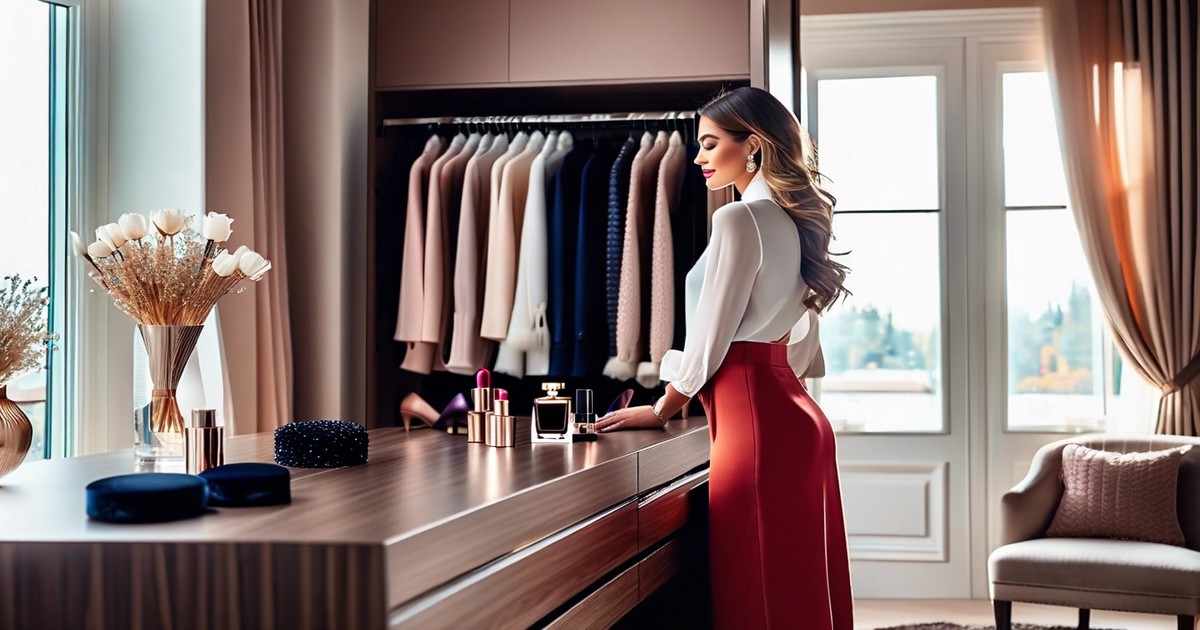The Complete Guide to the 4 Seasons Color Palette

Key Takeaways
- Seasonal color analysis sorts people based on undertone, value, and chroma into flattering palettes that resonate with color theory. When you match wardrobe and makeup to your season, it helps your features look brighter, clearer and more balanced.
- Master hue, value, and chroma to decode palettes with confidence. Employ the color wheel to identify warm/cool families, then construct ensembles with complementary contrasts that flatter your natural coloring.
- History reveals that the four-season system morphed into 12 subtle sub-seasons for greater accuracy. Dig into cutting-edge technology and virtual analyses to customize your palette beyond the traditional classifications.
- Identify your season through three tests in natural light: undertone, contrast level, and draping with varied shades. Record findings, contrast with seasonal characteristics, and build a basic spreadsheet of which colors brighten your complexion.
- Use your palette to select key neutrals and a couple of accents for a capsule wardrobe, coordinated makeup and accessories. Leave color swatches with you when shopping and strive for uniformity to simplify daily decisions.
- Amplify mood, confidence and personal/brand storytelling across fashion and design with your best colors. Keep things culturally savvy by adjusting palettes to local significance and keeping your top flatters.
🌸 Discover Your Seasonal Color Analysis
Ready to discover your seasonal color type? Our comprehensive seasonal color analysis will help you identify whether you're a Spring, Summer, Autumn, or Winter, and guide you to the perfect colors that enhance your natural beauty.
Discover Your Season →The four seasons color palette categorizes hues based on how they resonate with spring, summer, fall and winter tones.
It translates hue, value and chroma to actual characteristics like skin undertone, eye depth and hair contrast.
Spring reads warm and clear, summer leans cool and soft.
Fall has warm, rich depth, winter has cool high contrast.
To simplify selections, the palette provides pre-set color ranges and ensemble inspiration.
The following sections dissect each season with fast tips.
📚 Recent Articles
The science behind 4 seasons colors

Seasonal color analysis classifies individuals based on their inherent coloring—skin undertone, hair, and eyes—assigning them to specific colour types such as Spring, Summer, Autumn, or Winter. The aim is to achieve aesthetic balance through a well-defined seasonal color palette. Colors that reflect your undertone, value (light or dark), and chroma (soft or bright) enhance your overall coloring, making skin look even and features defined.
This approach utilizes the seasons color analysis system alongside vintage color theory and the color wheel, transforming it into wardrobe and makeup choices that harmonize with your individual colour palette.
Color theory
Hue, value and chroma are your 3 levers. Hue is the color family (red, blue, green). Value is the lightness or darkness of a color. Chroma is how pure or muted it looks. Seasonal palettes adjust these levers to suit warm, cool or neutral undertones.
The color wheel separates warm and cool areas. Warm hues lean toward yellow or gold. Cool hues tend toward blue or pink. Spring and Autumn sit on the warm side. Summer and Winter sit on the cool side, though some of us fall near neutral and can 'borrow' both.
Primary colors are red, blue and yellow. Stir them to obtain secondary (green, orange, violet), then combine again for tertiary. Seasons select variations of these — such as soft blue-green for Summer or bright blue-violet for Winter — by changing value and chroma.
Things that go together and things that are opposite matter. A Soft Autumn requires low-contrast, muted mixes. Like a Bright Winter, which gleams in sharp-contrast combos like black and icy cyan.
Historical context
Contemporary origins are 20th century theory sculpted by Johann Wolfgang von Goethe's thoughts on color perception and Albert H. Munsell's hue, value, and chroma system. Early image consultants employed these models to construct useful guides.
Thanks to books and consultants, the four-season concept took off and studio draping became a service. Names such as Suzanne Caygill and Carole Jackson, however, helped shove seasonal thinking into mainstream wardrobes.
The idea evolved into 12 or 16 sub-seasons — Light Spring, Clear Spring, Light Summer, etc. — to account for subtlety and neutral undertones found in people around the world.
Core principles
This is based on undertone (warm, cool, or neutral), value range and chroma. Skin that has more gold reads warm, more pink reads cool, and balanced reads neutral.
Natural hair, eye color and skin are a package. Imagine ash-brown hair with gray-green eyes and cool-beige skin for Summer. Or deep brown hair, dark eyes, Winter cool undertone.
Each season clusters related families: Summers lean to grays, mint greens, lilacs, and light blues. Winters to crisp black-and-white and gem tones. Springs to warm, clear brights. Autumns to rich, earthy notes.
When you wear your season, light, depth and clarity harmonize with your features, so skin appears velvety, teeth whiter and eyes sparkling.
What is your four seasons color palette?
Your four season color palette pairs your natural tone with colors from nature's cycle. Stylists evaluate drapes in natural light, no makeup or tan, to determine undertone, value (light to dark), intensity (soft to bright) and contrast.
Spring and Autumn are warm, Summer and Winter are cool. A lot of us slot better into a sophisticated 12-type system, but the four main seasons are still a great place to begin.
Six core swatches to map the range:
- Pumpkin — Hex #FF7518, RGP 255/117/24, CMYK 0/54/91/0, RAL 2008, Pantone 1585 C
- Maximum Yellow Red — Hex #F2BA49, RGB 242/186/73, CMYK 0/23/70/5, RAL 1003, Pantone 1235 C
- Azureish White — Hex #DBE9F4, RGB 219/233/244, CMYK 10/4/0/4, RAL 9016 (nearest), Pantone 656 C
- Little Girl Pink — HEX #F8BBD0, RGB 248/187/208, CMYK 0/25/16/3, RAL 3015 (closest), Pantone 705 C.
- Dark Spring Green – HEX #177245, RGB 23/114/69, CMYK 80/0/40/55, RAL 6001 (nearest), Pantone 348 C
- Persian Pink — Hex #F77FBE, RGB 247/127/190, CMYK 0/49/23/3, RAL 3015 (variant), Pantone 1905 C
Create a simple table at home: columns for Season, Undertone (warm/cool), Value (light/medium/dark), Intensity (soft/clear), Contrast (low/high), Best Neutrals, Best Accents. Space for Spring, Summer, Autumn, Winter.
Then match your hair, skin and eyes coloring to those characteristics to identify your season.
1. The spring palette
Warm, light and clear. Think Pumpkin and Maximum Yellow Red, with yellow-based brights that come across sunny and crisp.
Spring skin typically registers fair to golden with yellow undertones, eyes can be light hazel, green, warm blue. Bright, fresh, and cheery works best: peach, coral, warm turquoise, light cantaloupe, and soft lime.
Skip the heavy black, warm navy or camel instead. Clothes to try: peachy tees, light gold-brown jackets, warm turquoise scarves. Go for a golden and vibrant finish.
Keep metals warm–gold or bronze–instead of silver.
2. The summer palette
Cool, soft and muted. Azureish White and Little Girl Pink suggest the soft, powdery sensation. Skin is fair to pale with pink undertones. Contrast is low.
Classic picks: powder blue, pale lavender, soft rose. These colors mute redness and sooth the face. Opt for subtlety in fabric and shades in clothes and makeup—dusty rose blush, cool taupe shadow—for balance.
Maintain cool undertones, relying on gray, soft navy and rose-beige as neutrals.
3. The autumn palette
Rich. Warm. Earthy. Dark Spring Green and Pumpkin play with olive, rust and golden brown. Skin has warm undertones, eyes tend to appear mossy, amber or deep brown.
Wear deep tones, golden yellows and earth shades to get that natural glow. I'm talking olive green trousers, burnt orange sweaters, warm brown leather.
Neutrals: camel, chocolate, deep olive. Accents: mustard, terracotta, teal. The effect is warm, earthy, and welcoming.
4. The winter palette
Bold, cool, high contrast. Persian Pink, icy blues, emerald and ink-black suit crisp coloring. Skin demonstrates cool undertones, and there is a strong contrast between hair, eyes and skin.
Choose brilliant blue, emerald green and pure red. I'm thinking lots of crisp neutrals—black, optic white, charcoal and cool navy—for a clean edge.
Keep lines smooth. Saturated color close to the face adds punch. Silver, gunmetal and icy highlights maintain the sharpness.
A modern take on color analysis

Color analysis evolved from the initial concepts of Johannes Itten and Suzanne Caygill, both of whom associated natural coloring with the four seasons color analysis system. Today, it transcends a match and explores undertone, depth, intensity, and contrast to chart individual color palettes that resonate with personal colour analysis. Digital charts and virtual drapes make it easy to test options on a screen and track results, yet the goal stays the same: find colors that echo your own features and simplify getting dressed.
Beyond four
The 12-season system elongates Spring, Summer, Autumn, and Winter into mini-seasons that adjust hue, value, and chroma. This seasons color analysis explains why two individuals both labeled as "Autumn" can look best in different greens. Bright Spring sings clear, warm brights, while Soft Autumn adores muted, earthy blends that reflect their personal colour analysis.
These sub-seasons fill in cracks and provide advice applicable in a boutique, under artificial light, or in a studio. A seasonal color palette chart allows you to spot patterns in an instant, demonstrating temperature (warm vs. cool), depth (light vs. deep), and clarity (clear vs. soft).
Use it to short-list colors for a capsule wardrobe, enhancing your overall coloring. The gain is practical: fewer returns, faster outfits, and more ease on big days when you need to feel sharp. Many love how empowering it is, as it cultivates a calm style and enhances confidence in your decisions.
| Core Season | Sub-seasons (examples) | Key features |
|---|---|---|
| Spring | Light Spring, Warm Spring, Bright Spring | Warm, light-to-medium, clear; coral, peach, warm aqua |
| Summer | Light Summer, Cool Summer, Soft Summer | Cool, light-to-medium, soft; dusty rose, mist blue |
| Autumn | Soft Autumn, Warm Autumn, Deep Autumn | Warm, medium-to-deep, muted; olive, rust, camel |
| Winter | Bright Winter, Cool Winter, Deep Winter | Cool, deep, high contrast, clear; fuchsia, cobalt, black |
Precision keeps style feeling like you, not a costume. Sub-seasons eliminate guesswork and cancel clashes that sap the visage of vitality.
Finding nuance
Chroma, value, and intensity whittle down the list. High chroma likes crisp brights, low chroma likes muted. Value indicates how light or dark your best colors tend to be. Intensity follows contrast between your features, with higher contrast carrying bold pairings.
Test your side-by-side near-neighbor palettes in daylight. Contrast Bright Spring and Bright Winter reds, or Soft Autumn and Soft Summer greens. Look for harmony at the jawline and eye pop.
Keep notes on traits: cool vs. Warm, muted vs. Vivid, light vs. Deep. Note contrast level. Don't confuse skin tone with undertone, surface depth with what's underneath.
Go for baby steps. Trade one tee, scarf or lipstick. Use your phone gallery and a very simple grid to log wins. Virtual draping widgets and 12-season quizzes provide guidance, but your mirror and a unhurried eye are the final arbiter.
How to find your season

Color seasons connect your natural coloring with a seasonal color palette that balances undertone and contrast. A live check in daylight, without make-up or tan, provides the most accurate read. Be prepared to experiment with your personal colour analysis, as most folks fall between two colour types or exhibit characteristics of multiple.
- Set out tools and space. Get fabric swatches or printed swatch sheets for all four seasons, or use trusted online tools. Stand by a window in mid-day light, use a cream background, and pull hair off face.
- Test undertone initially. Employ fast exams—veins, steel and color reaction—to discern heat, cool, impartial.
- Judge contrast. See how much more richly your hair, your skin, your eyes vary in worth and in brilliance.
- Drape with respect to seasons. Try a few shades from each palette near your face and notice how your skin and eyes become clearer or muddier.
- List and rate. Record what softens skin, brightens whites of eyes, and evens tone, and what makes you look dull, yellow or gray.
- Find your season. Match undertone and contrast with usual seasonal profiles, noting subcategories such as light, deep, clear, soft and cool.
- Decide and edit. If a neat fit springs, excellent. Otherwise, trim to a pair of adjacent seasons and finesse with additional draping.
The undertone test
Begin with warm, cool, or neutral tones in your seasonal color palette. In natural light, examine your wrist veins: greener often indicates warm, while bluer or purple suggests cool, and mixed can be neutral. Notice which metal flatters you more: yellow gold tends to suit warm tones, while silver or white gold leans cool. Neutrals can wear both with ease.
Try different color reactions. Standout coral, tomato red, and warm camel can indicate a warm season, while fuchsia, true red, and cool gray may suggest a cool palette. If warm shades brighten your face, you may belong to a Spring or Autumn colour type. If cool shades calm your skin, you might be a Summer or Winter type. Neutral tones hint at a subcategory.
The results show that warm + light hair usually indicates a Spring colour type, while warm + dark hair might suggest Autumn. Conversely, cool + light hair often hints at Summer, and cool + dark hair typically aligns with Winter. Undertone tests are a great initial step, though they may not be conclusive.
Work without makeup, no fake tan – daylight!
The contrast level
Grab a mirror and a plain background. Contrast the worth differential in hair, skin and eyes. High contrast is like dark hair, light skin, and bright eyes. Low contrast appears softly near and far in value on features.
Find seasons. High contrast often suits a Winter. Medium might fit Autumn or Spring. Summer prefers. Select palates with coordinating contrast so prints, stripes and color blocks mimic your own pattern.
Not that some people blur lines. Subtypes — light, deep, clear, soft — help put nuance.
The draping method
Put bold swatches at the collarbone and the watch face, not the fabric. If a color blurs shadows, clears under-eyes, and brightens iris rings, hang on to it. If it turns skin sallow, gray or blotchy, throw it out.
Test across all four seasons: warm peach, butter yellow, tomato red (Spring); rose, dusty blue, soft navy (Summer); rust, olive, teal (Autumn); icy pink, cobalt, stark black (Winter). Rotate between near-neutrals too: cream vs. True white vs. Charcoal vs. Chocolate.
Log results post round. Some discover a distinct winner quickly, while others straddle the line between, such as Soft Summer and Soft Autumn. Hair depth matters: light hair often pairs with Spring/Summer; dark hair with Autumn/Winter, though blends exist. Holistic analysis trumps rigid boxes.
Applying your seasonal colors

Seasonal color application is about cultivating harmony through repetition, particularly within the seasons color analysis system. Play with shades from your individual colour palette that complement your skin, hair, and eyes, corresponding in undertone and intensity. All too often, we find ourselves near the edge of two seasons, and that's OK—concentrate on the common qualities—light, deep, warm, cool, soft, bright—and expand outward.
- Note your undertone and overall depth before buying anything.
- Carry a small swatch set in your bag while shopping.
- Choose neutrals first, then add accents from your palette.
- Repeat one palette color near your face every day.
- Edit items that clash; donate or dye when possible.
- It's easy when you align makeup, accessories and decor to your palette.
- Strive for uniformity, it just makes outfits and spaces look elegant.
Wardrobe building
Create a core checklist: jackets and trousers in your best neutrals; shirts and knits in light-to-mid values that suit your depth; one dark-proof piece for contrast if your season tolerates it; shoes and belts in matching neutral families; two to three accent tops or scarves that echo your eye flecks.
Springs and Summers (often lighter all around, hair lighter than medium brown) rely on light neutrals; Autumns and Winters can anchor with deeper, cooler or warmer hues as necessary.
Build a small capsule: 2 bottoms, 3 tops, 1 layer, 1 dress, 2 shoes, all within your palette so every piece pairs. It reduces decision fatigue and makes your mornings more efficient.
Shop adaptable basics—coats, denim, knits—solely in season-right neutrals for years of wear. Take swatches with you, and compare fabric colors to yourself in natural light. If you straddle seasons, select pieces that align with the key characteristic (e.g., deep) and experiment with chroma or warmth in your accents.
Makeup choices
Begin with undertone. Choose foundation that melts invisibly into your jawline in daylight, then blush that echoes your natural flush at a power walk. Select lipsticks that echo your season's warmth/coolness and worth–sheer coral for light warm Springs, rose-mauve for cool Summers, brick for warm Autumns, berry or blue-red for cool Winters.
Try accent colors in eye shadow and nails from your palette. A moss liner for Autumn, slate for Summer, teal for Spring, charcoal or sapphire for Winter.
Bypass tones that battle your coloring. Gray out? Too cool. Sallow? Too warm, or too muted. Overwhelm? Color is too brilliant for you.
Build a kit: 1 foundation, 1 concealer, 2 blushes, 3 lip colors, 1 neutral quad, 1 accent, 1 liner, 1 nail set, all season-true.
Beyond fashion
Echo your palette in scarves, bags, eye frames and metals that compliment your undertone. Even subtle hair color shifts should honor warmth/coolness and depth.
Use season-cohesive decor: sofa in a neutral that flatters you, throws and art in accents. It makes spaces calm yet personal.
Choose stationery, logos and web themes in palette colors. It fortifies personal branding.
If you drift between seasons, sample both, led by intensity, value and chroma. Some systems even grow to 12 seasons to further customize fit.
The psychology of seasonal color

Color nudges how we feel, how others interpret us, and how confident we are in ourselves. Something about the seasons color analysis system provides an uncomplicated context for these changes, connecting our inherent characteristics with a seasonal color palette that stabilizes mood, influences initial impressions, and sustains identity.
Emotional impact
Seasonal colors can cue calm or spark warmth. Soft Summer blues and misty mauves, on the other hand, have a way of slowing the pulse, like shade on a warm day. Bright Spring corals and clear aqua come across as upbeat and light, often read as friendly and active.
Autumn's earthy olive, rust, and golden yellow provide solace, reverberating wood, spice, and late sun. Winter's cool emerald and crisp black-white pairings feel focused and high contrast, which a lot of people interpret as sharp and driven.
Apply bright tones from your own paintbox on days when you require a boost. A Light Spring may choose melon or warm pink for a talk. A Deep Winter could rely on burgundy or cobalt for long work blocks.
Cognitive Science research shows color preferences vary seasonally. Golden yellow can translate into cozy fall and the crisp bite of an October breeze, so spin accents to congruent mood and month.
Pass on colors that sap you or make you question. If a hue proves to wash out your epidermis or cause you to squirm more, put it down. Most don't fall perfectly into one crisp season, but blur characteristics. Treat the palette as inspiration, not law.
Sensible selections support spirit and style. The correct undertone near the face can soften lines, brighten eyes, and trim self-conscious musings, which liberates attention for the work at hand.
Brand storytelling
Match your brand colors to your own season to stay message and presence aligned. When your logo, site, and wardrobe reflect the same undertones, you come across like a single distinct voice.
Seasonal psychology can inform strategy. A Winter‑leaning founder may opt for high contrast, cool hues for clarity and precision. An Autumn‑leaning maker could evoke craft and depth with textured greens and clay notes.
Consistency makes recall stick. Restrict the palette, define tints and shades rules, and replicate them across touchpoints. Pull causing feelings deliberately.
Because likes emanate from associated things and sensations, and because intellectuals from Aristotle to Plato examined color's influence, opt for tones that align with the feeling you desire your listeners to retain.
Cultural perception
Seasonal taste is not general. In some lands, white is bliss, in others — grief. Red can symbolize luck, danger, love, or protest. Personal history, too, warps significance — a teal jacket may seem courageous to me and insipid to you.
Respectfully adapt palettes. Maintain your base undertone, but adjust chroma and value to local standards in packaging, dress, or experiences. See what's happening globally in color trends for design and fashion, then sieve them through your season so you remain current, yet in harmony.
Seasonal colors have true psychological heft, but taste resides in individuals and context.
Conclusion
To bring it home, the four seasons color palette provides actionable guidance. The approach connects undertone, intensity and warm or cool notes in skin, hair and eyes. That makes it easier to choose colors that are near your own blend. Real wins arrive quickly. Less guesswork in stores. Quicker choices in your closet. Less returns. Sharper photos A more peaceful morning.
Little steps assist the most. Road test two tees in day light. Trade that berry lip for a cotton candy rose. Swap black for navy coat. Notice your face. Fresh. Dim. Warm. Cool. Let those cues drive your next purchase.
Ready to secure your palette! Post a selfie and your three favorite shades, request instant feedback.
Frequently Asked Questions
What is the Four Seasons color palette?
It's a seasons color analysis system that groups people into either Spring, Summer, Autumn, or Winter color types. Each seasonal color palette includes colors that complement your undertone, value, and chroma, helping to accentuate your natural assets.
How do I find my season?
Check your undertone first: warm, cool, or neutral. Then evaluate value (light/dark) and chroma (soft/bright) within the context of the seasons color analysis system. For maximum effect, employ natural light, a white tee, and curtains while considering your seasonal color palette.
What colors suit each season best?
- Spring: warm, light, clear (e.g., warm corals, light teal)
- Summer: cool, light, soft (e.g., dusty rose, soft navy)
- Autumn: warm, deep, muted (e.g., olive, rust)
- Winter: cool, deep, clear (e.g., true red, cobalt)
Can I mix colors from other seasons?
Sure, if they suit your undertone and contrast. Save your best neutrals for near the face, and consider incorporating seasonal color palettes. Just sprinkle on some 'off-season' colors in accents, accessories, and prints. Balance, not rules, is what ultimately counts.
Does seasonal color analysis work for all skin tones?
Yes. Undertone, value, and chroma are present in all skin tones. Experts think about depth and contrast, not just fairness. The outcome assists individuals from all walks of life select attractive colors with self-assurance.
How does psychology relate to seasonal colors?
Colors affect attitude and believing. Brilliant, cool colors from the seasonal color palette can feel fresh and dynamic. Warm, muted tones are grounded and approachable. When we are dressed in our harmonious colors, everyone notices, giving us confidence and presence.
What's a modern take on color analysis?
It combines traditional seasons color analysis with extended seasonal color palettes, individual style, and lifestyle demands. Most of the pros rely on digital tools, sub-seasons, and a more inclusive approach.